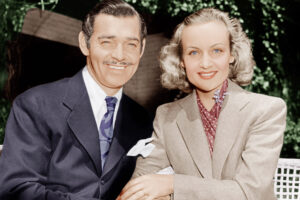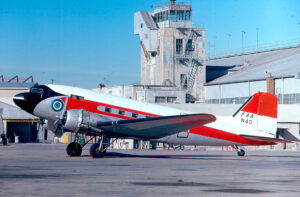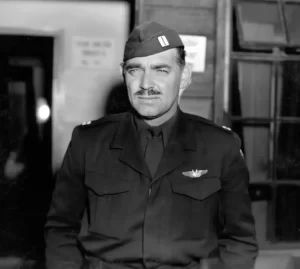
 Carole Lombard was a fierce patriot, and knew that her actor husband, Clark Gable wanted to get into the war. Lombard knew that Clark Gable was officer material. Still, at the time, he had other obligations, so he waited. That wait came to an end, a few months after Lombard was killed on January 16, 1942, when the plane on which she was a passenger, flew into a cliff. Lombard’s flight, TWA Flight 3 was a on a twin-engine Douglas DC-3-382 propliner, registration NC1946, operated by Transcontinental and Western Air (TWA). It was a scheduled domestic passenger flight from New York, New York, to Burbank, California, in the United States, via several stopovers including Las Vegas, Nevada. On January 16, 1942, at 7:20pm PST, just fifteen minutes after takeoff from Las Vegas Airport (now Nellis Air Force Base) bound for Burbank, the aircraft was destroyed when it crashed into a sheer cliff on Potosi Mountain. It was determined that n error in compass heading and the blackout of most of the beacons in the neighborhood of the accident made necessary by the war emergency caused the crash. Lombard, renowned for her roles in screwball comedies such as “My Godfrey” and “To Be or Not to Be,” and for her marriage to Gable was just 33 years old.
Carole Lombard was a fierce patriot, and knew that her actor husband, Clark Gable wanted to get into the war. Lombard knew that Clark Gable was officer material. Still, at the time, he had other obligations, so he waited. That wait came to an end, a few months after Lombard was killed on January 16, 1942, when the plane on which she was a passenger, flew into a cliff. Lombard’s flight, TWA Flight 3 was a on a twin-engine Douglas DC-3-382 propliner, registration NC1946, operated by Transcontinental and Western Air (TWA). It was a scheduled domestic passenger flight from New York, New York, to Burbank, California, in the United States, via several stopovers including Las Vegas, Nevada. On January 16, 1942, at 7:20pm PST, just fifteen minutes after takeoff from Las Vegas Airport (now Nellis Air Force Base) bound for Burbank, the aircraft was destroyed when it crashed into a sheer cliff on Potosi Mountain. It was determined that n error in compass heading and the blackout of most of the beacons in the neighborhood of the accident made necessary by the war emergency caused the crash. Lombard, renowned for her roles in screwball comedies such as “My Godfrey” and “To Be or Not to Be,” and for her marriage to Gable was just 33 years old.
Gable and Lombard met in 1932 during the filming of “No Man of Her Own.” At that time, Gable was beginning his as one of Hollywood’s top leading men, while Lombard was a talented comedic actress striving to prove herself in more serious roles. Both were married at the time. Gable was married to a wealthy Texas widow ten years his senior, and Lombard to actor William Powell. Initially, neither showed much interest in the other, but when they met again three years later, Lombard had divorced Powell, and Gable was separated from his wife. Their relationship then took a different turn. Much to the media’s delight, the new couple was open with their affection, calling each other Ma and Pa and exchanging quirky, expensive gifts. In early 1939, Gable’s wife finally granted him a divorce, and he married Lombard that April.
In January 1942, shortly after America’s entry into World War II, Howard Dietz, publicity director of MGM film studio, enlisted Lombard for a tour to sell war in her home state of Indiana. Gable, who had been asked to serve as the of the actors’ branch the wartime Hollywood Victory Committee, remained in Los Angeles, where he was set to begin filming “Somewhere I’ll Find You” with Lana Turner. Dietz advised Lombard to avoid airplane travel due to his fears about its reliability and safety, so she completed most of the trip by train, stopping at various locations en route to Indianapolis and raising approximately $2 million for the war effort.
It was a good trip, but Lombard was tired and didn’t want to wait for the train for the return trip. Instead, she boarded the TWA DC-3 in Las Vegas with her mother, Elizabeth Peters, and a group that included the MGM publicity agent Otto Winkler and 15 young Army pilots. Shortly after takeoff, the plane veered off course. Warning beacons that might have helped guide the pilot had been blacked out because of fears about Japanese bombers, and the plane smashed into a cliff near the top of Potosi Mountain. Search parties were able to retrieve Lombard’s body, and she was buried next to her mother at Forest Lawn Cemetery in Glendale, California, under a marker that read “Carole Lombard Gable.”
Overcome with grief and alone in the empty house he had shared with Lombard, Gable resorted to heavy drinking and struggled to complete his work on “Somewhere I’ll Find You.” He was consoled by concerned friends, including the actress, Joan Crawford. In August, following the Japanese attack on Pearl Harbor, Gable decided to enlist in the US Army Air Force. He spent the of the war in the United Kingdom and flew several combat missions (including one to Germany), earning multiple decorations for his efforts. He would marry twice more, but upon his death in 1960, Gable was interred at Forest Lawn, next to Lombard…his one true love.
Gable’s military service was marked by his dedication to aviation and combat operations. He was assigned to the 351st Bombardment Group as B-17 Flying Fortress gunner bomber pilot. His service was characterized by a combination of flying combat missions and supporting morale efforts. One of Gable’s notable contributions during the war was his involvement in the production of a documentary titled “Combat America” (1943). The film, produced and narrated by Gable, aimed to document the experiences of American bomber crews and underscore the importance of the war effort. This documentary was a significant endeavor and demonstrated Gable’s commitment to promoting the Allied cause.
While it was distinguished, Gable’s military service was not without its challenges. He faced the dangers of 
 combat missions and experienced the stresses and hardships of war. He was not mollycoddled because he was an actor. Over there, he persevered to be “just one of the men.” Despite these challenges, he remained committed to his duties and earned the respect of his fellow servicemen. Major Clark Gable’s military career was marked by his bravery and dedication to the war effort. He received the Air Medal and the Distinguished Flying Cross. His personal life might have been in a shambles, but his wife would have been very proud of his service.
combat missions and experienced the stresses and hardships of war. He was not mollycoddled because he was an actor. Over there, he persevered to be “just one of the men.” Despite these challenges, he remained committed to his duties and earned the respect of his fellow servicemen. Major Clark Gable’s military career was marked by his bravery and dedication to the war effort. He received the Air Medal and the Distinguished Flying Cross. His personal life might have been in a shambles, but his wife would have been very proud of his service.


Leave a Reply